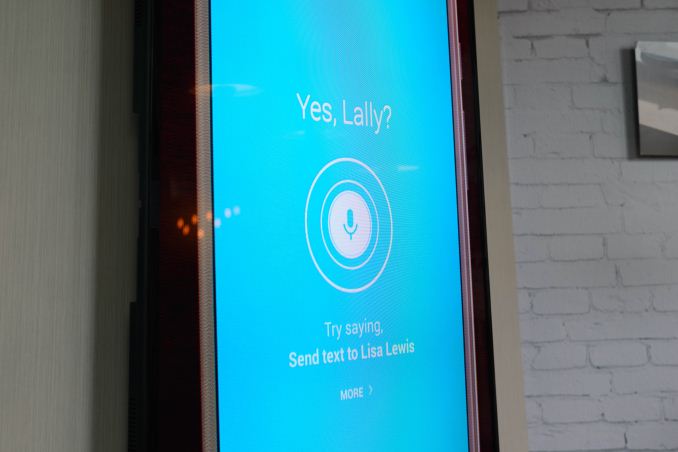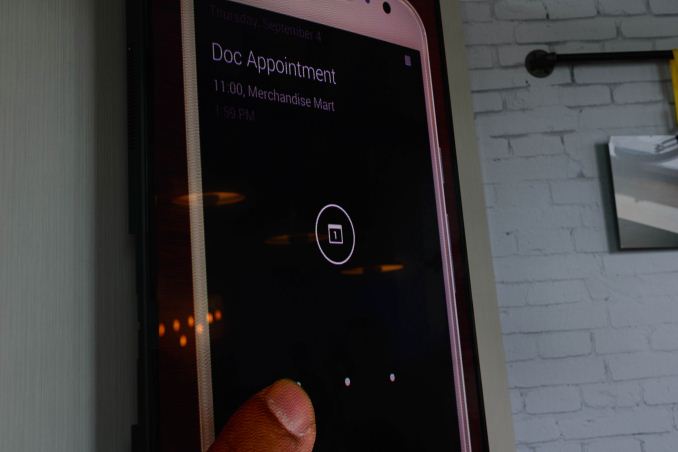Motorola Announces the New Moto X: Initial Impressions and Hands On
by Joshua Ho on September 5, 2014 2:00 AM EST- Posted in
- Smartphones
- Motorola
- Mobile
- Moto X
Moto Voice
While the original Moto X introduced Touchless Controls, the new Moto X takes things further. Now named Moto Voice, the new Moto X now allows for any five syllable phrase to be used. In addition, it’s possible for third party apps to plug into Moto Voice. Motorola demonstrated this by updating a Facebook status using voice controls, and it was said that YouTube and Whatsapp could be used through voice control as well. I believe that this is still using a TI chipset to enable voice control, although I need to take some time to dig for the exact chipset. Motorola noted that it will be able to distinguish between masculine and feminine voices quite well, and it should be able to be reasonably accurate at distinguishing between people even in situations where the owner and another person have masculine/feminine speech patterns. This system is still low power as always compared to running hotword detection off of the application processor (AP).
Moto Display is also present as the second generation of Active Display, and is now proximity based along with motion-based actions, which works by using the three IR transmitters and one IR receiver. This continues to use a low power DSP that is likely another TI solution. Motorola demonstrated how their solution is an order of magnitude lower in power compared to the same functionality implemented by a Play Store app for phones that lack Moto Display/Active Display. This was done wiring up a second gen Moto X and competing device to a power monitor.
Finally, Moto Actions adds some new gestures that leverage the previously mentioned IR transmitters and receivers. While some phones already have a similar feature, the main advantage of Motorola’s implementation is that the extra IR transmitters give much more leeway in how the gestures are performed. This means that a hand wave can be done at greater distances and with less need to wave directly over the top of the phone. This same hardware is used to enable the motion-based actions for Moto Display, which will turn on if it detects a hand wave or a face.
Attentive Display
While we’re still on the subject of sensor utilization, Attentive Display is another surprisingly well-implemented feature. Instead of constantly using the front facing camera to check whether or not to turn off, the feature relies upon the IR system to first detect whether there is a face in front of the phone, and then uses the front facing camera if a face is detected. Motorola claims that this change makes it possible for Attentive Display to save battery instead of hurting battery life like some competing solutions. In practice, I noticed that this is effective enough to actually tell when I’m not looking at the display, but the need for the front facing camera to verify means that this system doesn’t work in low light. I’d definitely like to see some form of low light system to make this feature work before I’d be willing to use it all the time with a very short display time-out.
Sound
While this is a relatively short section, it's still important as Motorola has implemented four microphones that are tuned for a variety of scenarios from driving to cafeteria-style scenarios, and also a custom noise cancellation solution that is neither provided by Audience nor Qualcomm. This helps greatly with Moto Voice, which is a major feature of note for the new Moto X.
On the speaker side, we see the same TFA9890 amplifier that first appeared in the Moto X, although a front facing speaker is used instead of a rear facing speaker. This drives approximately twice as much power to the speakers at maximum than what we see with the TFA9887 which is in some HTC devices.
Camera
For Motorola, this is camera represents a huge departure. While in the past they were almost exclusively an OmniVision customer, the OV10820 was likely a driving force in the move away from OmniVision for this generation. Instead, Motorola has moved to a Sony IMX135 13MP sensor, which is the same sensor that we've seen in the Samsung Galaxy S4, LG G2, LG G3, and a whole host of other smartphones. The new ring flash is said to reduce the severe shadowing that usually comes with flash photos, and the camera also runs a continuous buffer of photos and will automatically detect photos that are blurry or out of focus and will save photos from before and after the photo was taken in order to suggest them as replacements for a photo if they're sharper and in focus. Motorola also showed off a highlight reel feature that automatically generates short videos if it detects a large number of photos and videos taken in a single area.
Final Words
Normally, it's rare for me to take so long with a launch article, but this time Motorola has gone above and beyond what happens at a normal session before launch. Instead of just some time with the new devices, a few presentation slides, and relatively little information, we received a full tour of Motorola's new Chicago offices, which included an exclusive look at the RF labs and the extensive Faraday cage that runs all the way around the lab. While normally we see a trickle of information, this was an avalanche.
Overall, the new Moto X seems promising. The new metal frame, display, new customization options, better audio experience, and new sensor-based features could prove to be an intriguing option when compared to the other smartphones coming out at this time.
The new Moto X will be available later this month, with prices as low as 99.99 USD on contract and 499.99 USD in the US. It will also be available in Latin America, Asia, and Europe. Moto Maker will be available on AT&T, Verizon, Telcel in Mexico, Phones 4U in the UK, Orange in France, and Phone House in Germany.













108 Comments
View All Comments
erikiksaz - Friday, September 5, 2014 - link
Now this is why I love anandtech. Sum up all the specs in a chart (instead of of a 5 min video parroting back all the specs), and educate me on all the aspects of the phone that other websites simply do not cover.Thanks for the great preview.
Any more details on the color reproduction, sound quality/loudness of the speakers?
JoshHo - Friday, September 5, 2014 - link
The speakers are definitely quite good in quality, but I need to try some subjective comparisons and collect some data to really get a better idea of how sound quality is on the speaker.imaheadcase - Friday, September 5, 2014 - link
The one thing i don't like on my moto x is the speakers, you can't sit it on a flat surface because they are on back and muffles sound. kind of annoying when you want to watch videos on lunch break.imaheadcase - Friday, September 5, 2014 - link
Oic it HAS a front speaker? excellent news!craighamilton - Saturday, December 6, 2014 - link
The Moto X is not very popular if you look at consumer based reviews (such ashttp://www.topreport.org/phones/ which is my favorite).
JoJ - Monday, September 8, 2014 - link
Hi Josh, I'm new to your phone reviews, though not to this site, thank you for many years of providing great reference everyone, especially also the commenters here..Is it possible to test phones' speaker abilities by just putting them in a not so huge anechoic chamber? DIY, but I know you'd do a decent job, and providing some straight uncompressed recordings?
Several sites offer quite detailed measurements, but I'm not expert at understanding these, and differences all seem to fall within possible error margins. I'm simply thinking that a really good relative comparison would be to just soundproof a closet and run some tracks, preferably also from high resolution lossless files, at a range of volumes and microphone distances. Some real dynamic range classical, "noise war" pop, some operatic recitative is great for pinpointing hard to hear enunciation, maybe patch a phone in on speaker, to a conference call. Just enough so review readers could take, say, a half hour listen. Since so many have great headphones now, and many of those are studio monitor quality in flatness of response, I think this would work well.
As a kid, I very nearly took my studies to pursue a interest in sound engineering, but that's a very long time ago, however I remember many psychoacoustics reviews linking attention and perception of quality to both sound and video quality, basically perceived visual acuity would improve with greater audio fidelity, and similar correlations.
We spend a lot of time, now, with our phones. So much I have deliberately forgone use of anything but a very basic candy bar Nokia, just coming to six months now, exclusive use of a simple not even series 40 model, literally the flash ram is wearing out, it's so cheap. This is my last week or so!
My point is, that even with phablet phones, viewing a video, is something you often share, and so hearing comparison at a meter between phones would persuade me over anything other than a real deficiency in the screen. Poor audio has been the thing that I find causes my companions or colleagues to have difficulty understanding, not video, provided the video is smooth.
So having a idea of what these phones can sound like, for conferencing or music, at a meter or so, just as a comparison, forget graphs and numbers, would be really cool.
Please forgive me, if I have missed out on the parts of your test regime, which might give me a idea, but I'd be persuaded by any well managed real life sample, over test reports. To a certain extent, it feels like the eighties again, or before then, really, when getting any decent sound was a result, and the word "audiophile" was invented to excuse the measurebating.
I hope I'm not suggesting the all too obvious, instead just calling out a wish, but I was thinking the other day, about television reviews. About only one surprised me, to see something distinctly better, through YouTube's 1080 setting, and that as of a limited production Panasonic plasma, their last ever plasma. That seemed to shine through the obviously degrading signal chain. I am sure that great audio performance would shine through as well.
Are speakers generally deprecated? I mean, do most users .. no, most review readers, pay less attention to speaker ability, because they presume they'll be using their (very good) own headphones? If I was writing reviews, and selling adverts or anything to do with it, I'd be on the case to find out some numbers and opinions.
Thanks again & best from me,
~ joj
fokka - Friday, September 5, 2014 - link
i wanted to say the same thing, but you beat me to it.i hate having to read paragraphs of text, just to be able to tell what specs some device has. it's even worse when comparing different devices.
here we always get a nice chart, often comparing the reviewed piece of tech with its predecessor or competing products. this way i have a good overview in a matter of seconds.
thank you.
JoJ - Monday, September 8, 2014 - link
I agree with that, for sure!But I'm hijacking this early bit of the thread to as something dumb, that's kinda similar in terms of frustration with websites, or rather browsers: what happened to having text wrapped when you scale it on a phone or any other device for that matter? Opera Mini and Mobile used to do that, just fine. Okay, it did mess with layout a bit, but never so badly. Now I see no word wrap at all, and even in this Surface Pro 2, I don't have width enough when zoomed to appease older eyes, still keeping the page from overflowing... I simply do not want to horizontal scroll! Has anyone any ideas? I have tried lots of browsers, for sure, but no luck. Story of touch compatibility on a Surface is another thing altogether: I delayed the last Patch Tuesday because of the BSOD issue, and there's a few IE11 updates there. But, if a lot of things do not dramatically improve with IE11, I am going to write a very lengthy demand for a refund. That bad. On a metered connection and it won't recognize I darn well closed those thirty windows, two freaking shutdowns ago... and that's just one issue of many, and I really do wan to love this device...
Anyone know what happened to text wrapping for mobile browsers?
Why is - to my mind at least- such a vital usability feature not highlighted in reviews?
I am windows centric, but could care less about which platform I use, when it comes to usability.
hahmed330 - Friday, September 5, 2014 - link
Yeah awesome and highly professional preview... Moto X looks really promising considering how much attention to detail they have put in each and every solution. Motorola shames Samsung when it comes to attention to detail.Peroxyde - Friday, September 5, 2014 - link
Because other specialized "mobile" sites do quicker review. They shoot the phone with a bullet and check after if the phone is still working.